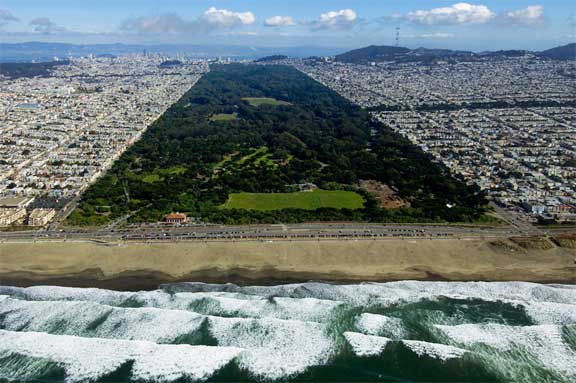Golden Gate Park in San Francisco is a classic urban park. It serves an invaluable role of providing a massive green and open space in the midst of one the most densely-populated cities in the United States. It is also a classic model of open space design and how it can be successfully integrated into the surrounding community. Although Golden Gate park is located in the western part of the city, away from the main tourist and higher-income areas, it has established itself as an attraction unto itself. Locals and visitors alike now go out of their way to visit Golden Gate Park, and what they experience is a crown jewel in the American urban park system.
Golden Gate Park is very large, with 1,017 acres comprising the total size of it. It is configured as a rectangle, in the same manner as New York's Central park, although Golden Gate is larger. The comparison to Central Park is no accident, as the park is often compared to it. In the late 1800s, residents of the rapidly developing city began to voice their desire for a park similar to the one that was being developed in New York City at the same time. Therefore, the original design s for the park were originally based on a desire to be as similar to Central park as possible. Frederick Law Olmsted, the mind behind Central Park, is often associated with the advent of Golden Gate Park. However, his ideas were merely used as a set of guiding principles in the creation of the park. Carved out of harsh sand dunes in the western part of the city, the park was established in a then-unincorporated section. Although the park was created by promoting open space and recreation opportunities, it actually contributed to the heavy development of the western side of the city, as new neighborhoods sprouted around the boundaries that were set aside. As viewed from the picture above, comparisons to Central Park are certainly inevitable. It is a massive green space squeezed into one of the most densely-populated areas in America.
The park contributes to the quality of life in the western part of the city, particularly the Richmond and Sunset districts, which border the northern and southern ends of the park, respectively. These neighborhoods are often ignored by tourists and actually remain relatively affordable and working-class in a city that has been characterized in recent years and decades by skyrocketing prices across the board. It is an asset that these neighborhoods enjoy such easy access to the jewel of the city park system. The western end of the city by the Pacific Ocean is more often than not blanketed in clouds and fog, even when the rest of the city is covered in sunshine. There are no hills directly on the coast in this area of town to break up the clouds, and therefore they tend to settle in comfortably in this area. This atmosphere at times lends a mysterious quality to Golden Gate, which is heavily forested. Numerous paths wind through the park where one can take in this atmosphere on a stereotypically foggy Bay Area day.
The park is a legendary location, especially in regards to the history of the counterculture and other large gatherings. San Francisco is generally considered to be the epicenter of American free-spiritedness, free thinking, and the counterculture movement that gained fame in the late 1960s. As the largest public park in the city, it became a popular free gathering place for many counterculture activities, a practice that continues to this day. It was the site of the Human Be-In in January 1967 that was a precursor to the Summer of Love, a time in history that marked the hippie movement and forever linked it to San Francisco, the neighborhood of Haight-Ashbury, and Northern California in general. It was a gathering and demonstration that focused the key ideas of the counterculture movement, and it attracted upwards of 30,000 people. To this day, it continues to be a key location of free events and music festivals, among other things.

Besides its historical importance, the park is also a an architectural and landscaping masterpiece. A particular highlight is the Japanese Tea Garden, the oldest public Japanese Garden in the United States. It opened in 1894 and features many peaceful paths and ponds. The park also features Stow Lake, the largest man-made lake of the park. Rowboats and pedal-boats can be rented for public use from a boathouse on the lake. A striking feature of the lake is the presence of Strawberry Hill, a large hill that is now an island in the lake and features an electrically-pumped waterfall. At the top of the hill, incredible views of the city are possible when clear, including a glimpse of the Golden Gate Bridge.
The park is truly an important piece of San Francisco culture. It is one the essential recreational and public gathering places in the city. It offers a much needed natural environment in a dense urban center. Its location comes with a certain number of issues, including high drug activity and a substantial number of homeless encampments. It offers prime resting spot in a city with the highest percentage of homeless people in the country. However, Golden Gate Park continues to hold its place high on the pedestal of premier urban parks in one of the most vital cities in the United States.



No comments:
Post a Comment